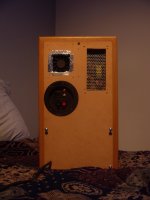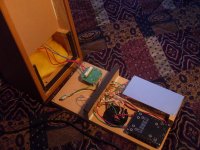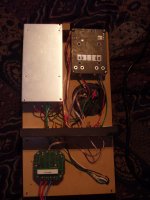I'm new to this website and to the world of audio equipment so please bear with me.
I want to put together a set of self powered speakers because I don't have a lot of extra room for an amplifier enclosure and I freakin hate clutter. That and it seems like a fun project.
I'm planning on using Infinity Sl30's for the speakers, a Sure 2x100w tk2050 amp, and a 24v 6a 145w switching power supply. The power supply is 7.8" x 3.8" x 1.5", and the amp is 5.8" x 4" x 1.3"
Because putting these inside the speaker will reduce internal volume, will it affect sound quality?
What do I need to know about component placement? Will the way I set it up affect sound quality? I guess I'm just looking for some tips or things to keep in mind. Or things not to do.
I want to put together a set of self powered speakers because I don't have a lot of extra room for an amplifier enclosure and I freakin hate clutter. That and it seems like a fun project.
I'm planning on using Infinity Sl30's for the speakers, a Sure 2x100w tk2050 amp, and a 24v 6a 145w switching power supply. The power supply is 7.8" x 3.8" x 1.5", and the amp is 5.8" x 4" x 1.3"
Because putting these inside the speaker will reduce internal volume, will it affect sound quality?
What do I need to know about component placement? Will the way I set it up affect sound quality? I guess I'm just looking for some tips or things to keep in mind. Or things not to do.
Last edited:
There's a possibility that sound pressure inside the cabinet could be picked up by amplifier components like film capacitors. I'm not saying it's a strong possibility, but just something to check for. Tap on the capacitors with a plastic rod and see if you can hear anything. I'd also be concerned about heat build-up. And, the possibility of failed components igniting flammable stuffing inside the cabinet.
It sounds like the amp and power supply could fit inside a 1U rack case; the Middle Atlantic EC1 is no-frills, solid steel, and American-made.
It sounds like the amp and power supply could fit inside a 1U rack case; the Middle Atlantic EC1 is no-frills, solid steel, and American-made.
Thanks for the input. I think I have the heat issue under control. I'm building it so the fan on the amp draws air from the outside of the speaker, pushes it past the psu and out of the speaker. Do you think a failed component could light the wood on fire? Neither the amp or psi will come in contact with stuffing, but the way I have it now both are in a plywood enclosure. ( I know mdf would be better, but seeing as the speakers are made of particle board, I figured it wouldn't make too much of a difference.)
Any openings in the cabinet will affect the tuning of the enclosure, since they'll behave like ports or maybe resistive elements or something.
Power supplies sometimes have varistors (MOVs) which tend to fail by exploding, if there isn't a fuse to blow. I've seen a humble op-amp that failed and somehow burned right through a glass-epoxy PC board. Wood is fairly hard to ignite, so it's more the stuffing I'd be concerned about. I found some nice scrap batts of fiberglass insulation in the attic to use on my speakers.
Power supplies sometimes have varistors (MOVs) which tend to fail by exploding, if there isn't a fuse to blow. I've seen a humble op-amp that failed and somehow burned right through a glass-epoxy PC board. Wood is fairly hard to ignite, so it's more the stuffing I'd be concerned about. I found some nice scrap batts of fiberglass insulation in the attic to use on my speakers.
I built a mostly sealed enclosure into the rear panel for the amp and psu. I'm waiting for a power cord for my camera to arrive, so pictures will have to wait.
Anyways it was working great for about 6 hours. I just turned it on and noticed some feedback. I grabbed the rca input line and heard a pop through the left speaker (the one that now holds the amp) The right speaker still works fine but the left one is very very quiet. I have the phono jacks for the input directly above the right speaker output. I'm guessing this caused the problem? Should I post a new thread in a different section for troubleshooting questions?
Anyways it was working great for about 6 hours. I just turned it on and noticed some feedback. I grabbed the rca input line and heard a pop through the left speaker (the one that now holds the amp) The right speaker still works fine but the left one is very very quiet. I have the phono jacks for the input directly above the right speaker output. I'm guessing this caused the problem? Should I post a new thread in a different section for troubleshooting questions?
I built a mostly sealed enclosure into the rear panel for the amp and psu. I'm waiting for a power cord for my camera to arrive, so pictures will have to wait.
Anyways it was working great for about 6 hours. I just turned it on and noticed some feedback. I grabbed the rca input line and heard a pop through the left speaker (the one that now holds the amp) The right speaker still works fine but the left one is very very quiet. I have the phono jacks for the input directly above the right speaker output. I'm guessing this caused the problem? Should I post a new thread in a different section for troubleshooting questions?
Update: I ran it without the right speaker plugged in and it worked fine. I think I need to do more testing before I post technical questions.
Oops, sorry mods I meant to edit that last one not quote it. The system is working again. I'm not 100% sure what the problem was but I've made sure the input and left speaker output don't come in contact.
Would you guys take a look at these pictures and tell me if you see any safety concerns or room for improvement? I monitored the temperature of the hottest area of the power supply for a few hours in 105 degrees F. ambient temp. and it never got over 130 degrees F. The probe was set about a millimeter away from the coil just visible in the first picture. I don't have an infared thermometer and I'm not sure I would be able to get an accurate reading through that metal grill so I didn't get an actual surface temp. Anyways it seems to run quite cool. The metal grill and the heat sink on the amp never get too hot to touch.
Would you guys take a look at these pictures and tell me if you see any safety concerns or room for improvement? I monitored the temperature of the hottest area of the power supply for a few hours in 105 degrees F. ambient temp. and it never got over 130 degrees F. The probe was set about a millimeter away from the coil just visible in the first picture. I don't have an infared thermometer and I'm not sure I would be able to get an accurate reading through that metal grill so I didn't get an actual surface temp. Anyways it seems to run quite cool. The metal grill and the heat sink on the amp never get too hot to touch.
Attachments
Last edited:
- Status
- Not open for further replies.
- Home
- Design & Build
- Construction Tips
- Passive to self-powered conversion


